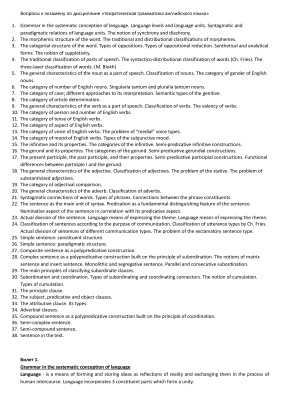Вопросов и ответов, полных, выполненных в соответствии с
государственным образовательным стандартом.
Вопросы
Grammar in the systematic conception of language. Language levels and language units. Syntagmatic and paradigmatic relations of language units. The notion of synchrony and diachrony.
The morphemic structure of the word. The traditional and distributional classifications of morphemes.
The categorial structure of the word. Types of oppositions. Types of oppositional reduction. Synthetical and analytical forms. The notion of suppletivity.
The traditional classification of parts of speech. The syntactico-distributional classification of words (Ch. Fries). The three-layer classification of words. (M. Blokh)
The general characteristics of the noun as a part of speech. Classification of nouns. The category of gender of English nouns.
The category of number of English nouns. Singularia tantum and pluralia tantum nouns.
The category of case; different approaches to its interpretation. Semantic types of the genitive.
The category of article determination.
The general characteristics of the verb as a part of speech. Classification of verbs. The valency of verbs.
The category of person and number of English verbs.
The category of tense of English verbs.
The category of aspect of English verbs.
The category of voice of English verbs. The problem of medial voice types.
The category of mood of English verbs. Types of the subjunctive mood.
The infinitive and its properties. The categories of the infinitive. Semi-predicative infinitive constructions.
The gerund and its properties. The categories of the gerund. Semi-predicative gerundial constructions.
The present participle, the past participle, and their properties. Semi-predicative participial constructions. Functional differences between participle I and the gerund.
The general characteristics of the adjective. Classification of adjectives. The problem of the stative. The problem of substantivized adjectives.
The category of adjectival comparison.
The general characteristics of the adverb. Classification of adverbs.
Syntagmatic connections of words. Types of phrases. Connections between the phrase constituents.
The sentence as the main unit of syntax. Predication as a fundamental distinguishing feature of the sentence. Nominative aspect of the sentence in correlation with its predicative aspect.
Actual division of the sentence. Language means of expressing the theme. Language means of expressing the rheme.
Classification of sentences according to the purpose of communication. Classification of utterance types by Ch. Fries. Actual division of sentences of different communication types. The problem of the exclamatory sentence type.
Simple sentence: constituent structure.
Simple sentence: paradigmatic structure.
Composite sentence as a polypredicative construction.
Complex sentence as a polypredicative construction built on the principle of subordination. The notions of matrix sentence and insert sentence. Monolithic and segregative sentence. Parallel and consecutive subordination.
The main principles of classifying subordinate clauses.
Subordination and coordination. Types of subordinating and coordinating connectors. The notion of cumulation. Types of cumulation.
The principle clause.
The subject, predicative and object clauses.
The attributive clause. Its types.
Adverbial clauses.
Compound sentence as a polypredicative construction built on the principle of coordination.
Semi-complex sentence.
Semi-compound sentence.
Sentence in the text.
Вопросы
Grammar in the systematic conception of language. Language levels and language units. Syntagmatic and paradigmatic relations of language units. The notion of synchrony and diachrony.
The morphemic structure of the word. The traditional and distributional classifications of morphemes.
The categorial structure of the word. Types of oppositions. Types of oppositional reduction. Synthetical and analytical forms. The notion of suppletivity.
The traditional classification of parts of speech. The syntactico-distributional classification of words (Ch. Fries). The three-layer classification of words. (M. Blokh)
The general characteristics of the noun as a part of speech. Classification of nouns. The category of gender of English nouns.
The category of number of English nouns. Singularia tantum and pluralia tantum nouns.
The category of case; different approaches to its interpretation. Semantic types of the genitive.
The category of article determination.
The general characteristics of the verb as a part of speech. Classification of verbs. The valency of verbs.
The category of person and number of English verbs.
The category of tense of English verbs.
The category of aspect of English verbs.
The category of voice of English verbs. The problem of medial voice types.
The category of mood of English verbs. Types of the subjunctive mood.
The infinitive and its properties. The categories of the infinitive. Semi-predicative infinitive constructions.
The gerund and its properties. The categories of the gerund. Semi-predicative gerundial constructions.
The present participle, the past participle, and their properties. Semi-predicative participial constructions. Functional differences between participle I and the gerund.
The general characteristics of the adjective. Classification of adjectives. The problem of the stative. The problem of substantivized adjectives.
The category of adjectival comparison.
The general characteristics of the adverb. Classification of adverbs.
Syntagmatic connections of words. Types of phrases. Connections between the phrase constituents.
The sentence as the main unit of syntax. Predication as a fundamental distinguishing feature of the sentence. Nominative aspect of the sentence in correlation with its predicative aspect.
Actual division of the sentence. Language means of expressing the theme. Language means of expressing the rheme.
Classification of sentences according to the purpose of communication. Classification of utterance types by Ch. Fries. Actual division of sentences of different communication types. The problem of the exclamatory sentence type.
Simple sentence: constituent structure.
Simple sentence: paradigmatic structure.
Composite sentence as a polypredicative construction.
Complex sentence as a polypredicative construction built on the principle of subordination. The notions of matrix sentence and insert sentence. Monolithic and segregative sentence. Parallel and consecutive subordination.
The main principles of classifying subordinate clauses.
Subordination and coordination. Types of subordinating and coordinating connectors. The notion of cumulation. Types of cumulation.
The principle clause.
The subject, predicative and object clauses.
The attributive clause. Its types.
Adverbial clauses.
Compound sentence as a polypredicative construction built on the principle of coordination.
Semi-complex sentence.
Semi-compound sentence.
Sentence in the text.

